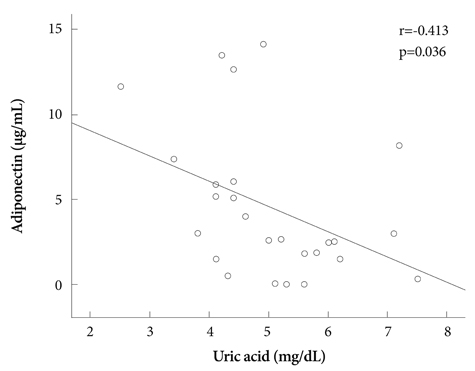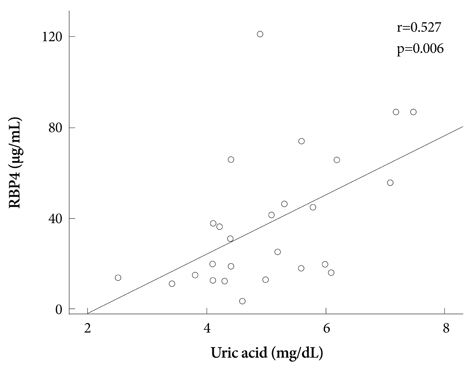Korean Circ J.
2011 Apr;41(4):198-202. 10.4070/kcj.2011.41.4.198.
Relationship Between Plasma Adiponectin, Retinol-Binding Protein 4 and Uric Acid in Hypertensive Patients With Metabolic Syndrome
- Affiliations
-
- 1Department of Cardiology, College of Medicine, The Catholic University of Korea, Bucheon St. Mary' Hospital, Bucheon, Korea. heartihmsh@yahoo.co.kr
- KMID: 2028944
- DOI: http://doi.org/10.4070/kcj.2011.41.4.198
Abstract
- BACKGROUND AND OBJECTIVES
Adipokines have been suggested for their potential use in tracking the clinical progress in the subjects with metabolic syndrome (MS). To investigate the relationship between the serum levels of adipokines {adiponectin and retinol-binding protein 4 (RBP4)} and the serum level of uric acid in hypertensive (HTN) patients with MS.
SUBJECTS AND METHODS
In this study, 38 totally untreated HTN patients were enrolled. Anthropometric measurements, blood pressure (BP) were taken in the 12 HTN patients without MS and the 26 HTN patients with MS. Fasting blood samples were collected for measurement of adiponectin, RBP4, nitric oxide (NO), glucose, creatinine, uric acid, lipid profile and insulin.
RESULTS
The HTN with MS group had significant higher values of body mass index, waist length, serum uric acid and triglyceride levels than the HTN without MS group. Compared to the HTN without MS group, the HTN with MS group showed significantly lower adiponectin (p=0.030), NO (p=0.003) and high density lipoprotein levels (p<0.001). Serum adiponectin levels negatively correlated with insulin level (R=-0.453, p=0.026) and uric acid level (R=-0.413, p=0.036), and serum RBP4 levels positively correlated with uric acid level (R=0.527, p=0.006) in the HTN with MS group. Multiple linear regression analysis using RBP4 and adiponectin levels as the dependent variables showed that uric acid level correlated with serum RBP4 level (p=0.046) and adiponectin level (p=0.044).
CONCLUSION
The HTN with MS group showed a correlation with two types of adipokines (adiponectin, RBP4) and uric acid. Adiponectin, RBP4 and uric acid may be important components associated with MS, especially when associated with hypertension.
MeSH Terms
Figure
Reference
-
1. Grundy SM, Cleeman JI, Daniels SR, et al. Diagnosis and management of the metabolic syndrome: an America Heart Association/National Heart, Lung, and Blood Institute Scientific Statement. Circulation. 2005. 112:2735–2752.2. Cuspidi C, Meani S, Valerio C, et al. Age and target organ damage in essential hypertension: role of the metabolic syndrome. Am J Hypertens. 2007. 20:296–303.3. Lakka HM, Laaksonen DE, Lakka TA, et al. The metabolic syndrome and total and cardiovascular disease mortality in middle-aged men. JAMA. 2002. 288:2709–2716.4. Ishizaka N, Ishizaka Y, Toda E, Nagai R, Yamamoto M. Association between serum uric acid, metabolic syndrome, and carotid atherosclerosis in Japanese individuals. Arterioscler Thromb Vasc Biol. 2005. 25:1038–1044.5. Coutinho Tde A, Turner ST, Peyser PA, Bielak LF, Sheedy PF 2nd, Kullo IJ. Associations of serum uric acid with markers of inflammation, metabolic syndrome, and subclinical coronary atherosclerosis. Am J Hypertens. 2007. 20:83–89.6. Culleton BF, Larson MG, Kannel WB, Levy D. Serum uric acid and risk for cardiovascular disease and death: the Framingham Heart Study. Ann Intern Med. 1999. 131:7–13.7. Ouchi N, Kihara S, Arita Y, et al. Adipocyte-derived plasma protein, adiponectin, suppresses lipid accumulation and class A scavenger receptor expression in human monocyte-derived macrophages. Circulation. 2001. 103:1057–1063.8. Yang WS, Lee WJ, Funahashi T, et al. Plasma adiponectin levels in overweight and obese Asians. Obes Res. 2002. 10:1104–1110.9. Graham TE, Yang Q, Bluher M, et al. Retinol-binding protein 4 and insulin resistance in lean, obese, and diabetic subjects. N Engl J Med. 2006. 354:2552–2563.10. Balletshofer BM, Rittig K, Enderle MD, et al. Endothelial dysfunction is detectable in young normotensive first-degree relatives of subjects with type 2 diabetes in association with insulin resistance. Circulation. 2000. 101:1780–1784.11. Alberti KG, Zimmet P, Shaw J, et al. The metabolic syndrome-a new worldwide definition. Lancet. 2005. 366:1059–1062.12. Katz A, Nambi SS, Mather K, et al. Quantitative insulin sensitivity ch-eck index: a simple, accurate method for assessing insulin sensitivity in humans. J Clin Endocrinol Metab. 2000. 85:2402–2410.13. Hong SP, Lee YS, Bae KR, et al. Relationship between serum uric acid level and metabolic syndrome according to gender. Korean Circ J. 2008. 38:152–160.14. Facchini F, Chen YD, Hollenbeck CB, Reaven GM. Relationship between resistance to insulin-mediated glucose uptake, urinary uric acid clearance, and plasma uric acid concentration. JAMA. 1991. 266:3008–3011.15. Yoo TW, Sung KC, Kim YC, et al. The relationship of the hypertension, insulin resistance, and metabolic syndrome in the serum uric acid level. Korean Circ J. 2004. 34:874–882.16. Chen CC, Wu JY, Chang CT, et al. Levels of retinol-binding 4 and uric acid in patients with type 2 diabetes mellitus. Metabolism. 2009. 58:1812–1816.17. Ingelsson E, Sundstrom J, Melhbus H, et al. Circulating retinol binding 4, cardiovascular risk factors and prevent cardiovascular disease in elderly. Atherosclerosis. 2009. 206:239–244.18. Patel DA, Srinivasan SR, Xu JH, Chen W, Berenson GS. Adiponectin and its correlates of cardiovascular risk in young adults: the Bogalusa Heart Study. Metabolism. 2006. 55:1551–1557.
- Full Text Links
- Actions
-
Cited
- CITED
-
- Close
- Share
- Similar articles
-
- Association of Plasma Retinol-Binding Protein 4, Adiponectin, and High Molecular Weight Adiponectin with Insulin Resistance in Non-Diabetic Hypertensive Patients
- Four-Year Change of Metabolic Syndrome Incidence According to Serum Uric Acid
- Interrelationship of Uric Acid, Gout, and Metabolic Syndrome: Focus on Hypertension, Cardiovascular Disease, and Insulin Resistance
- The impact of uric acid and metabolic syndrome on the incidence of hypertention in a Korean population
- Relationship between Serum Uric Acid and Metabolic Syndrome



